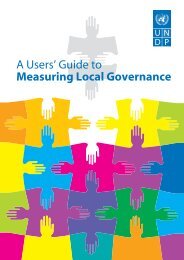planning a governance assessment - United Nations Development ...
planning a governance assessment - United Nations Development ...
planning a governance assessment - United Nations Development ...
Create successful ePaper yourself
Turn your PDF publications into a flip-book with our unique Google optimized e-Paper software.
Examples of sampling error rates at 95 percent certainty<br />
A sample size of:<br />
Give you a margin<br />
of error of around:<br />
2500 +/- 2.0 %<br />
1500 +/- 2.5 %<br />
1000 +/- 3.1 %<br />
500 +/- 4.4 %<br />
200 +/- 6.9 %<br />
100 +/- 9.8 %<br />
50 +/- 13.9 %<br />
Costs and benefits concerning sampling and sample size<br />
In conclusion, large samples cost more money, but offer more precision (better estimates). Probability sampling, which is<br />
usually more expensive, is preferred over non-probability sampling. However, in some cases non-probability sampling can<br />
work quite well and is used all over the world in large and small projects. If one is seeking the opinions of experts, then<br />
non-probability sampling is something to consider. Most of the time, the size of the sample is driven by how much money<br />
is available – more money, larger sample. The larger the sample, the more precise the estimates become and the easier it<br />
is to examine differences between groups in society. However, there is a point where the amount of precision gained by<br />
increasing the sample size diminishes. This means that even if resources are plentiful, there is no reason for excessively large<br />
sample sizes (see the examples offered above).<br />
When it comes to designing and drawing large representative samples, clearly NSOs have the experience and also may offer<br />
significant cost advantages. However, if the project is going to attempt to reach vulnerable populations such as domestics,<br />
homeless or displaced people, even NSOs may need to modify their “normal” sampling procedures. Getting to these hard to<br />
reach populations may require more time and money.<br />
Generally, it is better to have a well-executed study with a smaller sample, than a less rigorous study with a larger sample.<br />
Besides the costs associated with larger samples, you must also factor in the costs of designing, drawing (selecting the<br />
respondents) and managing the sample. If examining various groups in the population is a priority, then it would be wise to<br />
allocate sufficient funds for a sample large enough (with an acceptable MOE) to allow for disaggregation of the data.<br />
Planning a Governance Assessment: A Guide to Approaches, Costs and Benefits<br />
29








![GuÃa del Usuario ] - Governance Assessment Portal](https://img.yumpu.com/44740603/1/190x253/gua-a-del-usuario-governance-assessment-portal.jpg?quality=85)







